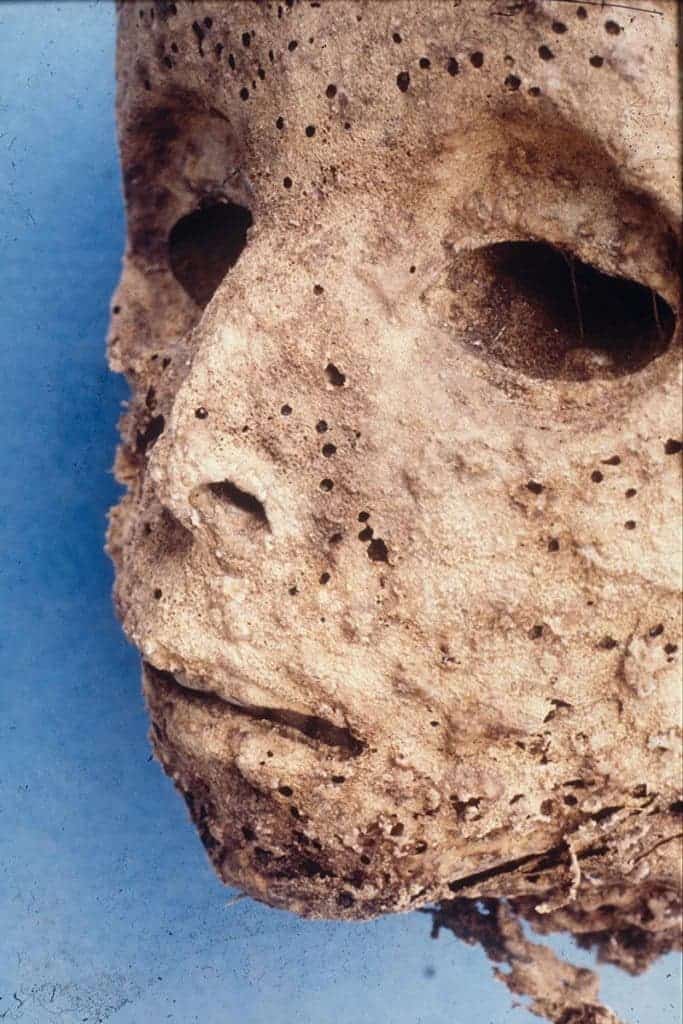After revisiting the remains of a 450-year-old mummy exhumed from an Italian church, scientists discovered the remains bore the oldest evidence of hepatitis B. Today, the virus actively infects 250 million people until now scientists have been unable to determine where and when the virus originated. This new finding just might help piece together the virus’ evolutionary history.

Headshot of the 2-year-old mummified boy which shows the earliest HBV infection. Credit: University of Pisa.
The mummy belongs to a boy who died in the mid-1500s, judging from radiocarbon dating. It is also likely that he was a part of a wealthy family, based on the fact that his corpse was embalmed — a costly practice — and dressed in silk clothes. For centuries, the mummy rested in the basilica of St. Domenico Maggiore in Naples until it was exhumed in the 1980s. Researchers at the time assessed that the boy must have died from smallpox, seeing how his body, particularly the torso, was covered in severe rashes. However, researchers at McMaster University and the University of Sydney have arrived at a different conclusion.
The team recently investigated the mummy’s DNA using modern techniques and found no evidence of smallpox. Instead, researchers found traces of hepatitis B virus DNA — the earliest such infection of which scientists are aware.
What’s striking is that the DNA of the mummy’s hepatitis B virus and that of modern strains differs very little. This means that the virus might have infecting people for thousands of years.
The earliest known infection of a virus that infects a third of all people globally
The hepatitis B virus (HBV) belongs to the Hepadnaviridae family of viruses. It causes hepatitis B, a disease that affects the liver. If the infection persists for more than six months, it can become chronic. And even if the infection is flushed out of the body, DNA from the virus will often still persist inside the host. Approximately 2 billion individuals in the world have evidence of past or present hepatitis B, and 2.2 million people in the U.S. are chronically infected with hepatitis B.
In very young children up to the age of five, the virus can also cause severe rashes which might explain the pockmarked skin of the Medieval boy.

(A) the mummy wearing funerary dress in the coffin, (B) the child’s mummified body prior to the autopsy, (C) the vesicopustular rash as evident on the facial features, and (D) this rash as evident on the arm. (E) Map displaying location of the Basilica of Saint Domenico Maggiore in Naples, Italy. Credit: PNAS.
It is also possible that the mummy was later contaminated with the virus rather than it being a very old infection. This seems rather unlikely, however, seeing how HBV DNA was extracted from all over the mummy’s body instead of in isolated locations. The researchers took eight samples of tissue from the distal femur, skin attached to one rib, skin attached to the frontoparietal bone, muscle from the thigh, and other skin samples. What’s more, the HBV DNA showed the kind of damage one would expect to see in ancient DNA.
If this is genuinely the oldest HBV infection — and that indeed seems to be the case — it means that HBV hasn’t changed much in the last 450 years, judging from its viral family tree. The virus’ genome is short and rigid which makes it vulnerable to mutations that could break it. As such, it makes sense that it has changed very little in the intervening years. It also means that the virus was already well adapted to infecting humans when it met the Italian boy in the 1500s. HBV might have been infecting people for thousands of years.
“This phylogenetic pattern indicates that the genotypes of HBV diversified long before the 16th century, and enables comparison of potential pathogenic similarities between modern and ancient HBV,” the authors reported in the journal PLoS Pathogens. “These results have important implications for our understanding of the emergence and evolution of this common viral pathogen.”
“If (the virus genome) is indeed from the 16th century, then this phylogenetic pattern indicates that the diversification of the HBV genotypes occurred prior to 1500 and that any subsequent accumulation of diversity was either lost through strong purifying selection of masked by multiple substitutions,” they conclude.









